gdflp
Super Moderator
      
Posts: 1320
Registered: 14-2-2014
Location: NY, USA
Member Is Offline
Mood: Staring at code
|
|
Preparation of 1,3-dibromopropane
Preparation of 1,3-dibromopropane
By gdflp
June 1, 2015
Introduction
1° Alkyl halides are in general a very useful class of molecules. They can be reacted with magnesium in an anhydrous inert solvent to yield Grignard
reagents, which can then be used to nucleophilically attack a variety of compounds, though this is considerably more difficult due to the presence of
two halogens and thus multiple competing side reactions. They can also undergo S<sub>N</sub>2 substitution with a variety of nucelophiles
such as hydroxide, cyanide, and azide. 1,3-dibromopropane in particular can react with sodium in refluxing dioxane, through an intramolecular Wurtz
reaction, to yield cyclopropane.
Reagents
Sulfuric acid used for the initial reaction was drain cleaner, Rooto brand, acid titrated at 90%; the sulfuric acid used for the washing step was a
higher quality 98% lab grade acid. 1,3-propanediol was a commercial, 99.9% anhydrous product and sodium bromide was "spa bromine", dried at 200°C
for one hour in an oven to ensure complete dehydration.
Procedure
A 500ml 3-neck round bottom flask is equipped with a pressure-equalizing addition funnel and a reflux condenser. Through the open neck, the flask is
charged with a stir bar, 100ml of distilled water, 154.5g of anhydrous sodium bromide(1500mmol), and 43.0ml of 1,3-propanediol(600mmol). The
graduated cylinder containing the diol was washed with 35ml of distilled water to dissolve any residues of the viscous diol; this washing was added to
the flask as well. The neck was stoppered and 150ml of 90% sulfuric acid(2500mmol) were charged into the addition funnel(Stopcock closed!). The
cooling water was turned on and the sulfuric acid was added at a rate of 1 drop/sec. During this addition, the mixture slowly took on a red
coloration and considerable heat was released.
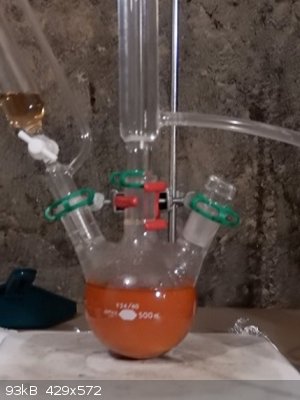 Reaction mixture near the end of the acid addition
Reaction mixture near the end of the acid addition
The addition funnel was then replaced with a stopper and the mixture refluxed for 2 hours. During this time, some hydrogen bromide is released from
the top of the condenser, thus this should be performed outside or in a fume hood.
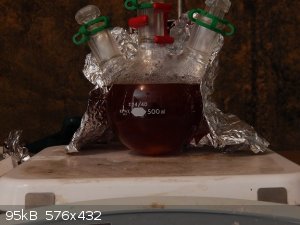 Reaction mixture after refluxing for two hours
Reaction mixture after refluxing for two hours
Reaction Workup
The mixture was allowed to cool slightly, and the reflux condenser was replaced with a simple distillation apparatus. Strong heating was begun and
the flask was insulated with aluminum foil. Distillate began to collect at a stillhead temp of 111°C, the distillate formed two layers in the
receiving flask as it was collected. The distillation was ceased when the stillhead temp rose to 120°C and the distillate ran clear. Alternatively,
to discern if the distillation is complete, stirring is momentarily halted; the buildup of a dense, dark red layer of liquid on the bottom of the
flask indicates the presence of 1,3-dibromopropane and distillation should be continued.
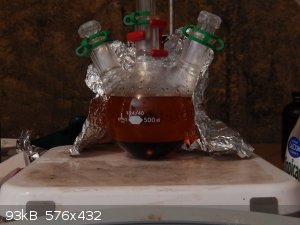 ]
Separation of layers after refluxing for two hours
Afterwards, the apparatus was allowed to cool and the distillate was transferred to a 250ml separatory funnel. The receiving flask was washed with
50ml of distilled water.
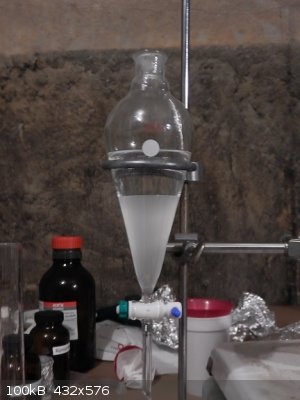 Distillate transferred to a separatory funnel
Distillate transferred to a separatory funnel
The lower organic layer was drained into a small beaker, the aqueous layer discarded, and the organic layer returned to the separatory funnel. It is
then washed with 11ml of cold, high quality, 98% sulfuric acid, and again, the lower organic layer is saved(due to the high density
of 1,3-dibromopropane, 1.99g/ml, it is prone to forming emulsions with sulfuric acid so this washing should not be too vigorous). Finally, the
organic layer is washed with 50ml of 10% sodium carbonate, and dried with anhydrous magnesium sulfate. The 1,3-dibromopropane is then gravity
filtered into a 100ml round bottom flask yielding a slightly cloudy crude product.
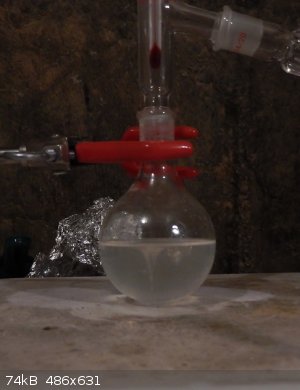 Slightly cloudy, crude product immediately prior to distillation
Slightly cloudy, crude product immediately prior to distillation
This was vacuum distilled, yielding a small amount of brown tar left in the flask.
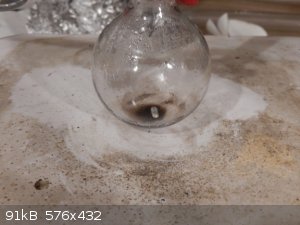 Tar left in the reaction flask after the vacuum distillation
Tar left in the reaction flask after the vacuum distillation
It passes over at around 115°C to yield 100.24g of 1,3-dibromopropane as a clear, colorless, dense liquid.
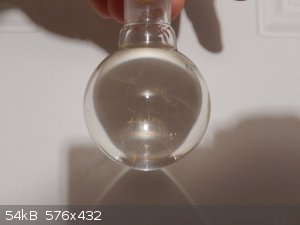 Final product after the vacuum distillation
Final product after the vacuum distillation
Discussion
The theoretical yield for this procedure is 121.1g or 60.9ml. The actual yield for the procedure was 100.24g, representing a yield of 82.77%. Yields
in this range are to be expected for this preparation. Org Syn reports an 85% yield on a six mole scale, thus at a 600mmol scale, based on this
yield, mechanical losses are not significantly greater and losses occur mainly during the initial reaction. The boiling point during the vacuum
distillation is rather high, this can be attributed to the lack of grease on any joints, lowering the achievable vacuum. During the vacuum
distillation, as there is a slight potential for 1,2-dibromopropane contamination in the final product from a carbocation rearrangement, a fractional
column should be used to separate and remove any 1,2-dibromopropane present, as well as residual water, by discarding the forerun.
References
1. Org. Synth. 1921, 1, 3 DOI:10.15227/orgsyn.001.0003
Comments, questions, and helpful criticisms would be greatly appreciated.
Edit(woelen): Corrected reference at the end of the post on behalf of gdflp
[Edited on 27-8-15 by woelen]
|
|
|
blogfast25
International Hazard
    
Posts: 10562
Registered: 3-2-2008
Location: Neverland
Member Is Offline
Mood: No Mood
|
|
Very nice work. Good write up.
|
|
|
CuReUS
National Hazard
   
Posts: 928
Registered: 9-9-2014
Member Is Offline
Mood: No Mood
|
|
I always have a doubt regarding Sn reactions.If you started with 1,3-propandiol,why won't the carbocation formed rearrange to form a secondary one,and
give you 1,2 dibromopropane instead ?
|
|
|
smaerd
International Hazard
    
Posts: 1262
Registered: 23-1-2010
Member Is Offline
Mood: hmm...
|
|
Cureus - Who says the reaction proceeds via SN1? It probably goes by SN2.
Excellent work here GdFlp. Clean write-up, nice pictures.
|
|
|
gdflp
Super Moderator
      
Posts: 1320
Registered: 14-2-2014
Location: NY, USA
Member Is Offline
Mood: Staring at code
|
|
Thank you blogfast and smaerd.
CuReUS, I see your point and there is likely some formation of 2-bromopropane, but the amount is almost certainly negligible. Obviously, the alcohol
will first be protonated in the highly acidic solution, but there are potentially two pathways at this point. The heavily dominating pathway is the
nucleophilic attack of this pronated oxygen by bromide(which is present in excess) by an S<sub>N</sub>2 mechanism. There may be a slight
chance of the formation of a 1º carbocation by loss of the oxygen, but this is unfavorable due to the very high instability of these carbocations.
Once the carbocation is formed, there are again two potential pathways. The first is again a reaction with bromide, yielding the desired product,
while the other is a hydride shift yielding a 2º carbocation and ultimately 2-bromopropane as you suggest. However, I think that the combination of
the favorability of the S<sub>N</sub>2 pathway in the presence of a large concentration of bromide, and the extreme instability of the 1º
carbocation, cause the formation of 2-bromopropane to be highly unlikely and thus form in only minimal amounts.
[Edited on 6-4-2015 by gdflp]
|
|
|
UC235
National Hazard
   
Posts: 565
Registered: 28-12-2014
Member Is Offline
Mood: No Mood
|
|
Excellent writeup. Good pictures, nice details.
A few comments. You could probably forgo the first distillation and decant/sep funnel off the lower layer, wash with sulfuric (removes residual
alcohol, ether products, and alkenes), and vac distill to yield the final product.
You mention that after drying with MgSO4, your liquid was still cloudy post-filtration. Why? I know that the magnesium sulfate can be kind of dusty,
but If you don't think that is the problem, I would suspect that maybe you didn't use enough dessicant.
Any 1,2-dibromopropane that might have formed could be removed of by slapping a column onto the vacuum distillation setup and discarding any forerun.
The 1,2 isomer boils 29C below the 1,3 isomer. Note: While I am a strong proponent of foil tents for the average distillation or reflux where
temperature control is not particularly important, a vacuum fractionation needs a sand or oil bath for stability.
|
|
|
CuReUS
National Hazard
   
Posts: 928
Registered: 9-9-2014
Member Is Offline
Mood: No Mood
|
|
instead of using NaBr and acid,I wonder if the reaction could be done using Al foil and Bromine,like how methyl iodide is made from
methanol,I2 and Al foil
btw,thank you for clearing the Sn confusion.
|
|
|
PHILOU Zrealone
International Hazard
    
Posts: 2893
Registered: 20-5-2002
Location: Brussel
Member Is Offline
Mood: Bis-diazo-dinitro-hydroquinonic
|
|
Quote: Originally posted by CuReUS  | instead of using NaBr and acid,I wonder if the reaction could be done using Al foil and Bromine,like how methyl iodide is made from
methanol,I2 and Al foil
btw,thank you for clearing the Sn confusion. |
It should work aswel:
2Al + 3I2 --> 2AlI3
AlI3 + CH3-OH --> CH3(+) + HO-AlI3(-)
CH3(+) + HO-AlI3(-) --> CH3-I + Al(OH)I2
Al(OH)I2 + CH3-OH --> CH3(+) + (HO-)2AlI2(-)
CH3(+) + (HO-)2AlI2(-) --> CH3-I + Al(OH)2I
Al(OH)2I + CH3-OH --> CH3(+) + (HO-)3AlI(-)
CH3(+) + (HO-)3AlI(-) --> CH3-I + Al(OH)3
--------------------------------------------------------
6CH3OH + 2 Al + 3 I2 --> 6 CH3-I + 2 Al(OH)3
Side reactions?
CH3(+) + I2 --> CH3-I + I(+)
I(+) + I(-) (from one of the aluminium complexes) --> I2
I(+) + CH3-OH --> CH3(+) + HO-I (+ CH3-O-I + H(+))
-but with Br2 the reaction will be very exothermic...much more than with I2.
-but methyl is quite different from other alkylic groups and so you may have cation rearrangement.
PH Z (PHILOU Zrealone)
"Physic is all what never works; Chemistry is all what stinks and explodes!"-"Life that deadly disease, sexually transmitted."(W.Allen)
|
|
|
gdflp
Super Moderator
      
Posts: 1320
Registered: 14-2-2014
Location: NY, USA
Member Is Offline
Mood: Staring at code
|
|
Quote: Originally posted by UC235  | Excellent writeup. Good pictures, nice details.
A few comments. You could probably forgo the first distillation and decant/sep funnel off the lower layer, wash with sulfuric (removes residual
alcohol, ether products, and alkenes), and vac distill to yield the final product.
You mention that after drying with MgSO4, your liquid was still cloudy post-filtration. Why? I know that the magnesium sulfate can be kind of dusty,
but If you don't think that is the problem, I would suspect that maybe you didn't use enough dessicant.
Any 1,2-dibromopropane that might have formed could be removed of by slapping a column onto the vacuum distillation setup and discarding any forerun.
The 1,2 isomer boils 29C below the 1,3 isomer. Note: While I am a strong proponent of foil tents for the average distillation or reflux where
temperature control is not particularly important, a vacuum fractionation needs a sand or oil bath for stability. |
Thank you. At first when I was reading the OrgSyn prep, I was thinking that I might be able to skip the first distillation as well. The issue was
the strong red coloration of both the product and acid layers after the reflux period. I wasn't quite sure what it was and I'm still not sure, it
wasn't bromine as evidenced by the lack of any vapors during the reflux, the lack of any scent of bromine, and the color staying when poured into an
excess of a sodium bisulfite solution for disposal. I'm guessing that it's some form of charring due to the sulfuric acid and, in hindsight,
shouldn't affect anything as long as the product was vacuum distilled. I simply wasn't sure at the time, and decided to just distill it to be
safe(the distillation was quite fast though, the product distilled completely in slightly under 45 minutes).
In regards to the desiccant, I suspect that the cloudiness was due to some magnesium sulfate with a particle size small than that of my medium pore
fluted filter paper. When I was drying it, it wasn't clearing as much as I would like, so I kept adding small amounts of desiccant. I had a large
excess of desiccant at the end, a large amount had absorbed little to no water, as evidenced by a lack of any clumping or sticking to the walls of the
flask, after allowing it to dry for about an hour.
I fully agree that I should have used a fractional column during the vacuum distillation. At the time, I hadn't thought of the potential for any
1,2-dibromopropane. I don't think there was much, if any, 1,2-dibromopropane since the stillhead temp shot up to 115°C and stayed there throughout
the entire distillation(with a little bit of variance due to fluctuations in the vacuum), but there wouldn't be any downside. I have added a note to
the original post, thank you for the advice.
[Edited on 6-4-2015 by gdflp]
|
|
|
PHILOU Zrealone
International Hazard
    
Posts: 2893
Registered: 20-5-2002
Location: Brussel
Member Is Offline
Mood: Bis-diazo-dinitro-hydroquinonic
|
|
Now you can addapt this procedure to pentaerythritol (C(CH2OH)4 or 2,2-dimethylol-propan-1,3-diol) because propan-1,3-diol is related to it --> to
get the pentaerythritol tetrabromide (C(CH2Br)4)   
The mixing of 1,3-dibromopropane or of tetrabromo pentaerythritol with a saturated methanol/water AgNO3 solution would allow one to get nitric esters
without use of H2SO4 or HNO3; without heat and thus in a much safer way...
Br-CH2-CH2-CH2-Br + 2AgNO3 --> O2NO-CH2-CH2-CH2-ONO2 + 2 AgBr(s)
C(-CH2Br)4 + 4 AgNO3 --> C(-CH2ONO2)4 + 4 AgBr(s)
As extra advantages AgBr is easily recollectable as precipitate and recyclable due to its light sensitivity...
2 AgBr -sunlight-> 2 Ag + Br2(g or l)
Ag + HNO3 --> AgNO3 + NxOy + H2O
3Br2 + 2Al --> 2AlBr3
AlBr3 + 3H2O --> 3 HBr(g) + Al(OH)3(s)
HBr + NaOH --> NaBr + H2O
PH Z (PHILOU Zrealone)
"Physic is all what never works; Chemistry is all what stinks and explodes!"-"Life that deadly disease, sexually transmitted."(W.Allen)
|
|
|
CuReUS
National Hazard
   
Posts: 928
Registered: 9-9-2014
Member Is Offline
Mood: No Mood
|
|
I had another doubt.Is there a chance of a cyclic ether forming,as conc sulphuric acid is being used.Because in the acetaldehyde thread,some members
tried to make acetaldehyde from ethane 1,2-diol,but they ended up with dioxane instead.
Quote: Originally posted by PHILOU Zrealone  |
AlI3 + CH3-OH --> CH3(+) + HO-AlI3(-)
CH3(+) + HO-AlI3(-) --> CH3-I + Al(OH)I2
Al(OH)I2 + CH3-OH --> CH3(+) + (HO-)2AlI2(-)
CH3(+) + (HO-)2AlI2(-) --> CH3-I + Al(OH)2I
Al(OH)2I + CH3-OH --> CH3(+) + (HO-)3AlI(-)
CH3(+) + (HO-)3AlI(-) --> CH3-I + Al(OH)3
--------------------------------------------------------
6CH3OH + 2 Al + 3 I2 --> 6 CH3-I + 2 Al(OH)3
|
good explaination.I used to think the Al would first reduce the I2 to HI,which would then react with methanol to give methyl iodide
|
|
|
gdflp
Super Moderator
      
Posts: 1320
Registered: 14-2-2014
Location: NY, USA
Member Is Offline
Mood: Staring at code
|
|
Quote: Originally posted by CuReUS  | I had another doubt.Is there a chance of a cyclic ether forming,as conc sulphuric acid is being used.Because in the acetaldehyde thread,some members
tried to make acetaldehyde from ethane 1,2-diol,but they ended up with dioxane instead.
|
Yes, that does happen to an extent, on some substrates more than others. The main purpose of the washing with conc.
H<sub>2</sub>SO<sub>4</sub>, in addition to removing excess alcohol, is to remove any ethers present. Some cleavage of the
ether occurs in the acidic solution, leaving more alcohol/sulfate ester, while some of the ether simply becomes protonated by the sulfuric acid. All
of these are soluble in sulfuric acid and insoluble in alkyl bromides, thus they are removed from the organic layer during this washing.
[Edited on 6-4-2015 by gdflp]
|
|
|
Lambda-Eyde
National Hazard
   
Posts: 860
Registered: 20-11-2008
Location: Norway
Member Is Offline
Mood: Cleaved
|
|
Nice writeup, good work. Where did you source the propanediol? I've been wanting it for a while for some other synthesis, but haven't been able to
find it for less than the price of heroin or something.
This just in: 95,5 % of the world population lives outside the USA
Please drop by our IRC channel: #sciencemadness @ irc.efnet.org
|
|
|
Magpie
lab constructor
    
Posts: 5939
Registered: 1-11-2003
Location: USA
Member Is Offline
Mood: Chemistry: the subtle science.
|
|
Very nicely presented. Good discussion of the chemistry between you and others.
My only criticism is about the lack of good lighting on some of the pictures.
Cyclopropane huh? Isn't that potentially explosive? I think in the old days it was used as an anesthetic.
The single most important condition for a successful synthesis is good mixing - Nicodem
|
|
|
gdflp
Super Moderator
      
Posts: 1320
Registered: 14-2-2014
Location: NY, USA
Member Is Offline
Mood: Staring at code
|
|
Thanks both. I obtained the propanediol as a free sample from Dupont here. I have found conflicting data, but my understanding is that while cyclopropane contains a significantly larger amount of energy per mole
due to ring strain, it is not considerably more explosive than other, similar, straight chain alkanes.
|
|
|
Lambda-Eyde
National Hazard
   
Posts: 860
Registered: 20-11-2008
Location: Norway
Member Is Offline
Mood: Cleaved
|
|
Yeah, exactly the same place where I requested a sample probably two years ago... Never heard anything from them, even though I filled in my company
info...
This just in: 95,5 % of the world population lives outside the USA
Please drop by our IRC channel: #sciencemadness @ irc.efnet.org
|
|
|
Zephyr
Hazard to Others
  
Posts: 341
Registered: 30-8-2013
Location: Seattle, WA
Member Is Offline
|
|
Just wanted to thank you for the great write up gdflp!
I tried this out about a week ago to great success at half your scale and was very pleased with a 92% yield.
Also notable is that my reaction was less reddish and much darker, almost black.
Thanks ~Pinkhippo11
[Edited on 9-29-2015 by Pinkhippo11]
|
|
|
gdflp
Super Moderator
      
Posts: 1320
Registered: 14-2-2014
Location: NY, USA
Member Is Offline
Mood: Staring at code
|
|
Glad to hear it worked well.
I just ran this reaction on 1-propanol and 1-butanol, it's exactly the same procedure, but twice the molar amount (1200mmol) of alcohol was used for
obvious reasons. Unfortunately, I was running them simultaneously and I ran out of ice, so the condenser ran a little hot and I lost some product.
Yield was only around ~75% for both, which still isn't terrible. The only major difference I noticed was that the reaction mixture was a much lighter
color after refluxing, similar to the light orange in the picture above during the acid addition during the run with 1,3-dibromopropane, rather than
the dark red I observed, and near black Pinkhippo observed, with the latter substrate. I'm wondering if there are more decomposition products with
the diol due to more side reactions, as a similar issue is observed when one tries to synthesize a Grignard reagent with it. Only a ~30% yield is
observed of the Grignard reagent prior to addition of the electrophile due to side reactions, and that's after the reaction was optimized and a
different ether was used. See DOI:10.1002/anie.198709901 for more info, http://www.sciencemadness.org/talk/viewthread.php?tid=62326&...
|
|
|
|